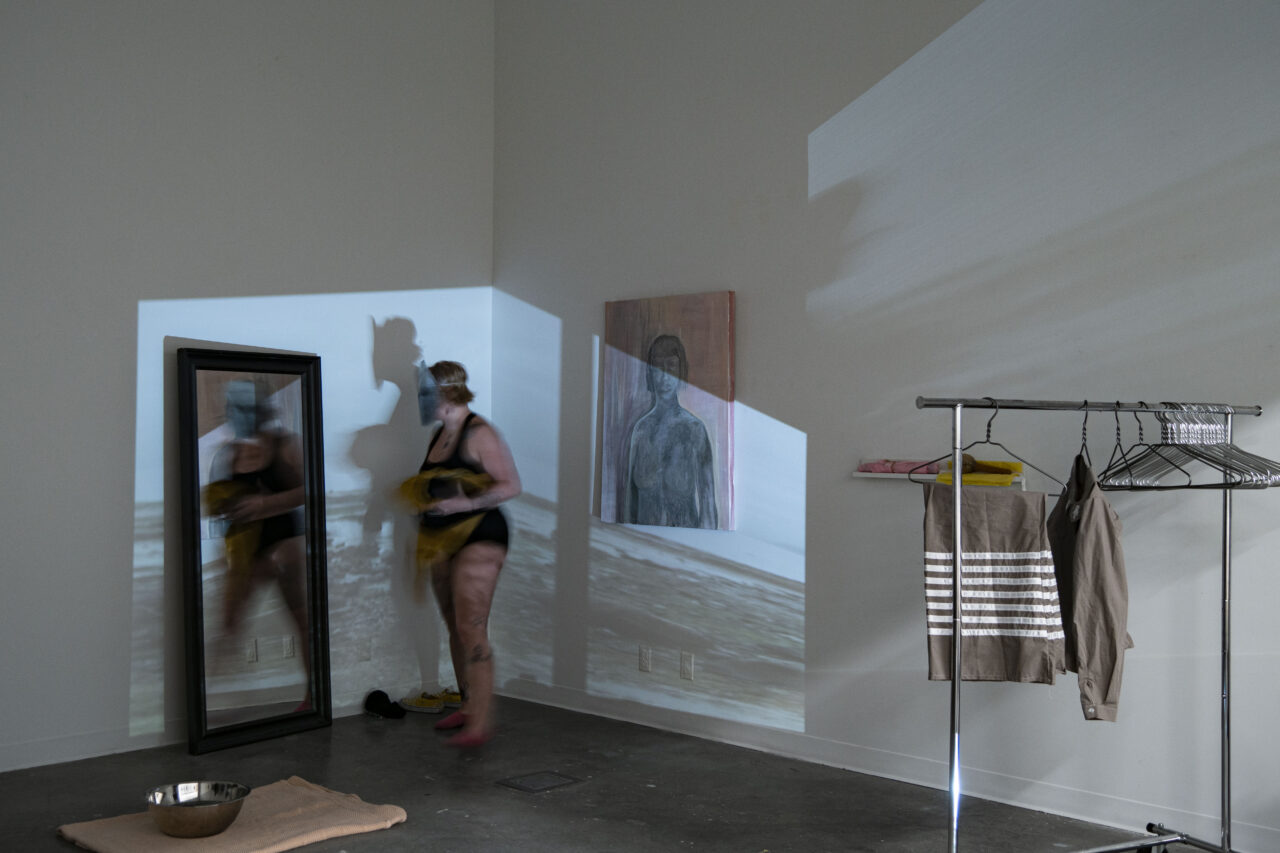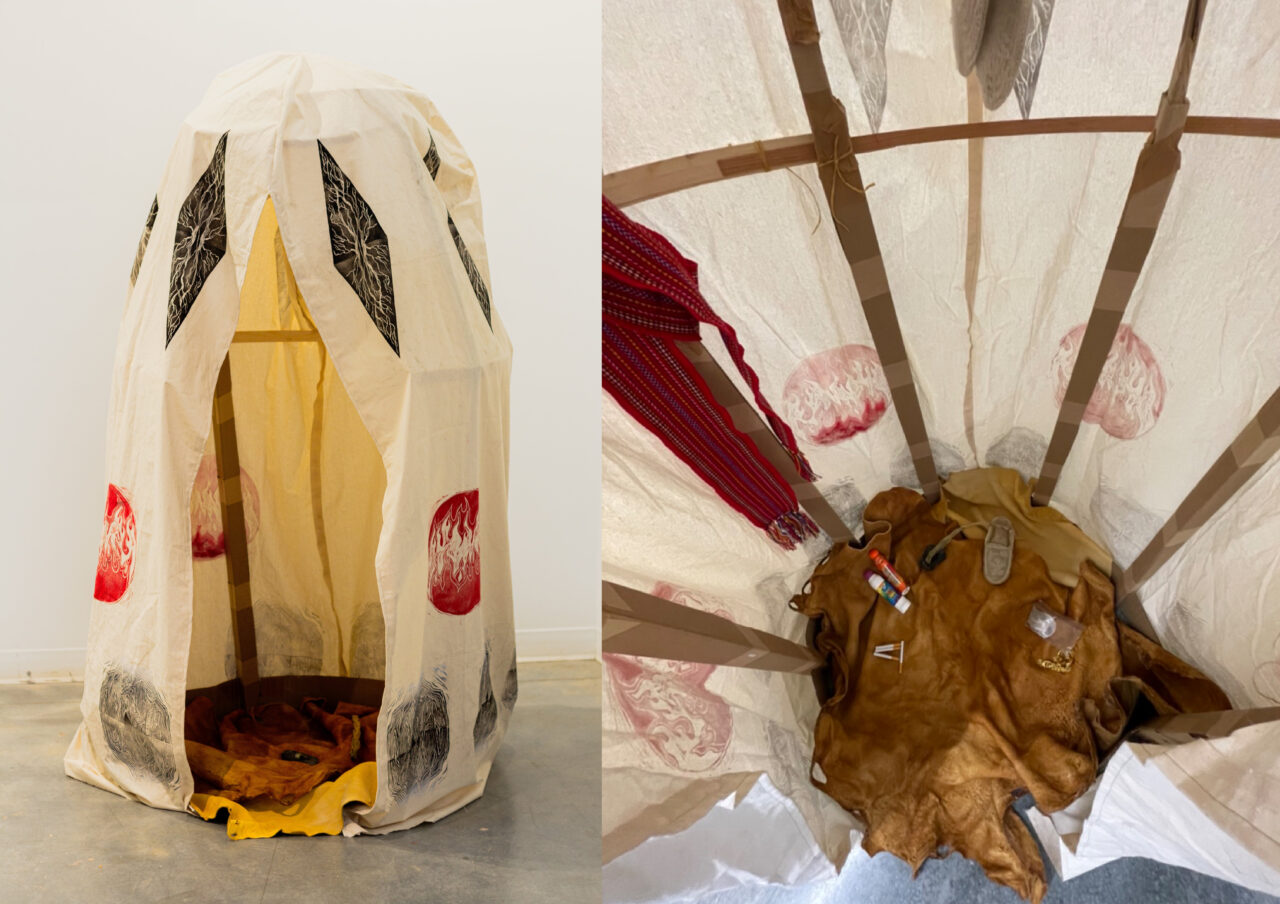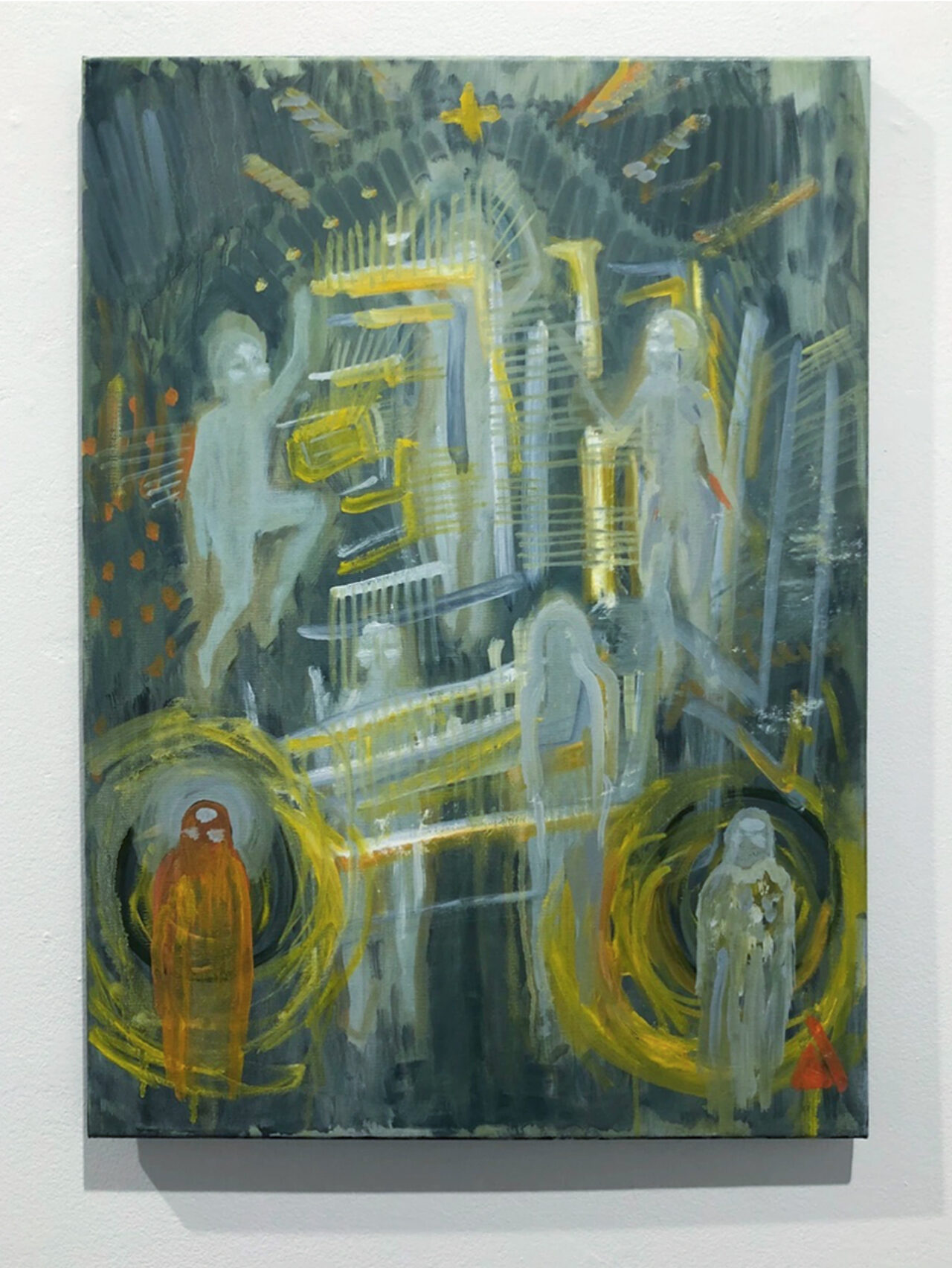Ribbons and Radars: Stepping Into Interdimensional Decolonization

Zoë Laycock with Dismantled -2, in the Sacred Fires exhibition, 2023. Handmade ribbon skirt & shirt, human hair, beeswax, video projection, mirror, screen print. (Photo by Kimberly Ronning / courtesy Zoë Laycock)
Posted on | Updated
The paranormal, cultural transmission, Indigenous futurism, time, spectrality and existences in artist and MFA student Zoë Laycock’s work.
Every so often, her pastel hair changes between cotton-candy pink, bleach blonde, and light blue. Add that to her grounded demeanor and passion for bingo, and Zoë Laycock might not be what you expect when meeting a paranormal enthusiast.
She’s now stepping further into the unknown. Entering the second half of her Masters of Fine Arts degree, Zoë’s exploring how to connect with the spirit world through interdimensional communication. Not a straightforward task.
Connecting to the Beyond
To evoke a sense of otherworldliness, her installations turn towards the spiritual. As an Anishinaabe Red River Métis woman, her work takes inspiration from a multitude of sources; her grandparents’ clothes, homemade regalia, her flower beadwork, ceremonial spaces, and pop-cultural uses of ghost radars you’d see in movies and reality TV dramas (think Ghost Hunter). Even sounds of the Rocky Mountain lakes and shorelines near Exshaw, Alberta - one of her most treasured homes - trickles into her installations.

Zoë Laycock, Mazinaatebiigishin (s/he casts a shadow on the water, is reflected in the water), 2022. (Photo by Geoff Cheung / courtesy Zoë Laycock)
“My desire to occupy spaces to facilitate communication and sites of belief, of the beyond, fundamentally comes from my traditional knowledge and understanding that we are all connected” remarks Zoë.
“Human and non-human, physical and non-physical bodies, the spirit world, the Earth, the cosmos, and all in between.”
Zoë is a multidisciplinary artist. Her immersive, theatrical, A/V practice ultimately brings her closer to finding how we can better communicate with otherworldly beings.

Zoë Laycock, Interdimensional Radio + detail, 2021. (Photo courtesy Zoë Laycock)
She’s connected to the paranormal through compulsions. Take, for example, her Bachelor of Fine Arts project, Interdimensional Radio.
She initially didn’t realize what she was making, even while making it. “It was a compulsion to build a thing that had a certain dimensions and shapes,” reflects Zoë. After talking with family, Zoë was surprised to discover she had made a shaking tent: an old-school ceremonial space where one person would have an intimate, direct contact with the spirit world.
“Europeans used to think it was evil,” Zoë notes. The practice became less frequent as word spread of its capacity to connect to the spirits.
Despite this attempt at erasure, Zoë has rekindled a connection to her ancestors.

Zoë Laycock, Aga indinawemaaganidog (All of my Relatives in Shadows), 2023 – ongoing. (Image courtesy Zoë Laycock)
Fitting it together
Like puzzle pieces, Zoë considers how to use props and technology to project sounds and imagery for spectral play. Through her lifelong engagement in Saulteaux ceremony, she’s careful to follow protocol and actively resist appropriation of what she holds sacred.
Onlookers also get an opportunity to connect with their Indigenous ancestry and blood memory, because Zoë’s work compels us to challenge our perspective.
“It’s exciting for me to engage with the paranormal and cultures around entity encounters, to facilitate connections that tease between the disturbing and the playful,” she notes.
When not getting lost in the ether, Zoë explores her ideas in a grounded way: “I almost start with a place, and a huge assemblage of ideas of what will be the next iteration goal. Then as time progresses, I work backwards, engaging with timeframes, materials, and all the planning and problem solving that will eventually enact the iteration goal.”
During her studies at Emily Carr, she’s leaned into an iterative, ever-evolving practice: “Finality doesn’t seem to fit my MO these days,” she says.
To unwind, Zoë beads for fun. She’ll sneak in a quick jam session if she’s visiting family and friends and will pull out rubber blocks to do a quick linocut. “I think the beauty of accepting myself as an interdisciplinary artist is that I can do whatever feels right in that moment,” she adds.
This summer, Zoë’s hopping on a train through the United States, documenting paranormal phenomena in haunted houses, burial grounds, ghost towns and odd-ball ceremonial spaces. Travelling on the train will give Zoe an opportunity to be closer to the land, understand temporality, and better introduce herself to spirits that dwell nearby.

Zoë Laycock, What's Going To Happen, 2019. (Image courtesy Zoë Laycock)
Connecting to community in our world
As Interim Aboriginal Programs Coordinator, Zoë helps students and visitors alike. Aside from wrapping drumstick hides, sewing seal fur into jewelry and making rattles, she prepped ECU students for the inaugural Indigenous Art Market.
Prior to working at the AGP, Zoë was an Indigenous youth and family support worker for a decade, involving herself with community work in Calgary. Her passion for cultural accessibility and grassroots work clearly continues to this day.
“I am also so fortunate and deeply grateful to have grown up with a deep connection, understanding, and participation in my Indigenous community,” Zoë says.
Here at the Aboriginal Gathering Space, we’re lucky to see her at work. Both as an artist and an active community member, we look forward to seeing her ever-changing interdimensional iterations.
Find more of Zoë’s work by visiting her website.
--
Julie McIntosh is a writer, communications consultant and Master of Design student at Emily Carr University. Learn more about her work via her website.
This article was originally produced for the Aboriginal Gathering Place at ECU.